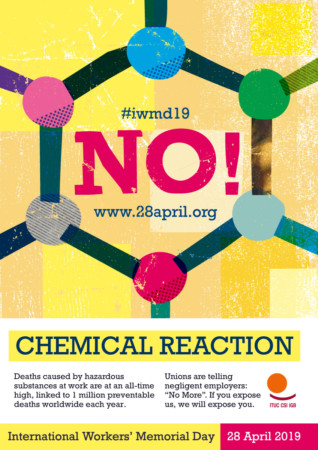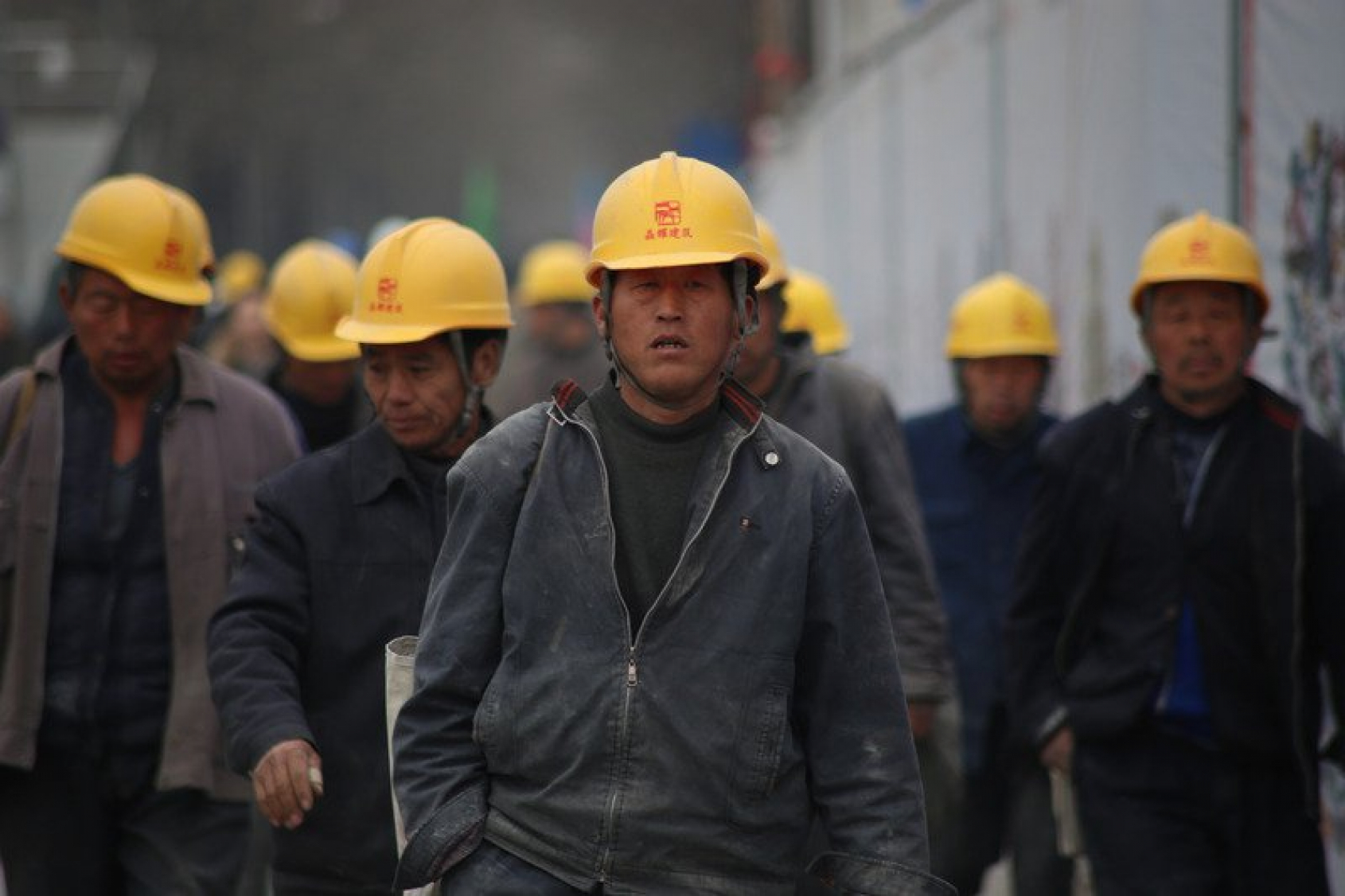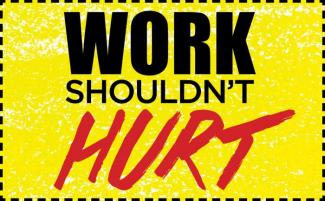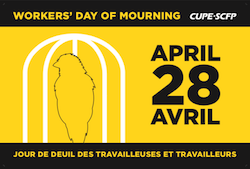BWI Kenya affiliates (KUPRIPUPA, KQMWU, UNRISK and KBCTFIEU) organized a workplace campaign at Inter label printing industry in Nairobi on 25th April to sensitize the workers on health and safety and strengthen the OHS committee.
BWI Kenya affiliates (KUPRIPUPA, KQMWU, UNRISK and KBCTFIEU) organized a workplace campaign at Inter label printing industry in Nairobi on 25th April to sensitize the workers on health and safety and strengthen the OHS committee.
In Jordan, the BWI affiliate GTUCW celebrated International Workers’ Memorial Day in Amman on the 26th April with a meeting of the union’s leadership on the safety and health issues concerning migrant workers.
“Pray for the dead and fight like hell for the living! “Mother Jones
 ADAO joins individuals, trade unions, and organizations around the world for International Workers Memorial Day on April 28, 2019 for those who have been injured or killed on the job For decades, unions and NGOs like The Hazard Campaign and AFL-CIO have commemorated this important day with activities and awareness events around the world where people are uniting, taking a stand, and making sure their voices are heard.
ADAO joins individuals, trade unions, and organizations around the world for International Workers Memorial Day on April 28, 2019 for those who have been injured or killed on the job For decades, unions and NGOs like The Hazard Campaign and AFL-CIO have commemorated this important day with activities and awareness events around the world where people are uniting, taking a stand, and making sure their voices are heard.
AFL-CIO said, “On April 28, the unions of the AFL-CIO observe Workers’ Memorial Day to remember those who have suffered and died on the job and to renew the fight for safe jobs. It is a day where working people come together to call for action on hazards that cause unnecessary injury, illness and death. We will stand united against the ongoing attacks on workers’ rights and protections and demand that elected officials put workers’ well-being above corporate interests.”
The Hazards Campaign has produced a variety of Workers’ Memorial Day resources to support unions and activists with their April 28 event planning including stickers, posters, purple ribbons, high-visibility WMD jackets, and a new poster for #IWMD19.
According to the World Health Organization, “125 million people in the world are exposed to asbestos at the workplace.” Armed with the facts, we know that knowledge is stronger than asbestos. Through our continued efforts to prevent exposure to asbestos including our recent Asbestos Awareness Week April 1-7 and the Alan Reinstein Ban Asbesto Now Act of 2019 (ARBAN)– we hope to prevent the needless deaths of individuals both in and out of the workplace.
With support from the Hazard Campaign, AFL-CIO, the American Public Health Association (APHA) and 11 other public health and occupational safety organizations, ADAO is confident in ARBAN’s success and an asbestos free future for workers across America.
To follow the conversation online, follow the hashtag #IWMD19. You can also help by signing the petition to ban asbestos now without any loopholes or exemptions, and keep workers safe from the dangers of asbestos.
In solidarity,
Linda Reinstein
Social Networks

Le 28 avril, Jour de deuil national, nous rendons hommage aux personnes décédées, blessées ou devenues malades en raison de leur travail.
Nous avons au quotidien l’occasion de prévenir les blessures et les décès en milieu de travail, mais nous ne pouvons le faire que si nous disposons des données nécessaires pour prendre nos décisions.
Au Canada, nous recueillons des statistiques sur de nombreux sujets, dont la météo, mais nous ne consignons pas avec précision les statistiques sur le nombre de personnes qui sont décédées en raison de leur travail. Par conséquent, nous ne tirons pas les leçons qui nous permettraient de prévenir de telles tragédies.
Aucun ministère ou organisme au Canada ne recense les cas de décès et d’accidents en milieu de travail; seule la Commission des accidents du travail compile ces données. Les 951 décès largement cités dans les statistiques de 2017 (la plus récente année disponible) de l’Association des commissions des accidents du travail du Canada (ACATC) ne devraient pas être le seul indice de référence pour déterminer le nombre de décès ou de blessures liés au travail. Les statistiques de l’ACATC tiennent uniquement compte des demandes d’indemnisation approuvées, et non du total réel des blessures et des décès survenus au cours d’une année donnée. Des recherches récemment effectuées au pays démontrent que le nombre de décès liés au travail pourrait être jusqu’à 10 à 13 fois plus élevé que celui indiqué dans les données officielles.
On peut conclure en l’absence de rapports que des milliers de cas de blessures et de décès ne figurent pas dans les statistiques sur la santé et la sécurité au travail. Il s’agit notamment de ceux des travailleuses et travailleurs sans couverture (les travailleurs autonomes, le personnel des banques, les travailleuses et travailleurs domestiques, de nombreux fermiers et travailleurs agricoles), des personnes décédées sur la route alors qu’elles se rendaient au travail ou en revenaient, des personnes qui se suicident à cause du stress, des cas de maladies professionnelles non approuvées, du personnel des clubs privés et des travailleurs temporaires ou sans papiers.
De plus, dans le secteur fédéral, lorsqu’une personne décède après avoir été exposée à un danger particulier, la commission d’indemnisation ne fournit pas l’analyse des causes fondamentales aux employeurs. Le coroner ne donne pas d’avis de décès à l’employeur, et la cause fondamentale de la blessure ou du décès n’est pas nécessairement prise en compte dans le programme de prévention des risques, ce qui est contraire à l’exigence. C’est comme si tout décès était un « accident ».
Mettons tout en œuvre pour que cette année 2019, le gouvernement du Canada commence à documenter et à utiliser avec précision les données probantes pour prévenir les blessures au travail et sauver des vies. Un seul, c’est un de trop : personne ne devrait mourir au travail!
http://syndicatafpc.ca/seul-cest-trop-personne-ne-devrait-mourir-travail

By Victor Figueroa, ITF strategic researcher
Occupational Safety and Health (OSH) are crucial issues for workers everywhere in the world. Over decades workers in different countries have won recognition for their right to work in safer environments. In some countries OSH regulations are a key tool in defending workers’ rights.
The 28 April is a day for workers everywhere to remember the struggles of the past, but also to project these struggles forward. For example, new technologies and work practices based on them are creating new challenges to worker health and safety, and new technologies also offer new opportunities to protect existing rights.
Amazon’s high-tech carrot and stick
This week I was in Spain discussing how new technology affects workers in Amazon facilities there and I was horrified at the level of control and the complete lack of consideration of worker well-being evident in the way tech is used in the warehouses. As a tech leader and a growing company, Amazon is a worrying example of the challenges that increasing numbers of workers will face in future, as monitoring and benchmarking technologies become more widespread.
Workers described to me how technology is being combined with company culture and intimidation to create a high-pressure environment rife with injuries and stress. ‘Power hours’ and ‘Ready, Steady, Go!’ systems are combined with positive exhortations (‘the kids won’t get their presents if we don’t smash this target!’) provide the carrots, while technology provides the stick to create a working environment where people are labouring at the limit of their endurance for hours and days at an end. The physical and mental toll is severe.
The Amazon workers spoke of operating under the supervision of algorithms that set the pace of work, with no-one knowing what the criteria being used were, or who had decided they were possible or reasonable. The actual work rate and the target work rate used to be displayed above some work stations, but managers found workers would slow down a bit if they were above the target rate, and so the indicator was removed. Workers work harder if they have no idea if they are meeting their targets. It helps to beat targets if managers and supervisors chivvy people along with the dreaded ‘estas flojo’ (you’re behind).
Over monitored, overworked
On top of this, chipped ID cards tell the system where workers are, and track them around the facility. Workers’ every movement is followed and team ‘leads’ or managers jump on the smallest infraction. Workers can lose two or three days’ pay for leaving a door ajar, for example. Workers also reported surveillance cameras in the changing rooms, but nobody knows who has access to the footage or what it is used for. It is another example of tech not being transparent to workers.
But technology does not just track the Amazon workers’ around the facility, it also conditions their work rate. Screens at workstations show where workers should put items, and scanners scan items as they are moved about. The algorithms decide what goes where when, and how long it should take you. The same movements are carried out again and again. One worker said, “it turns you into a robot and you are left numbed”. Workers in some workstations are literally in a cage for eight hours at a time with no social contact at all, in order to keep them away from the robots that bring them the shelves. “You could collapse in there and nobody would know” they said. One worker spent two months in the cages. “I wanted to die at the end of each shift”, they said.
The workers are carrying out hundreds, sometimes thousands of repetitions of the same movement in every shift, causing high rates of injury over time. The most common injuries are to wrists, hands and knees, although in some workstations it is back injuries. The company refuses to accept the injuries happen on the job, with managers accompanying workers reporting injuries while union reps are kept away. ‘You don’t want to work?’, some are asked by the managers. Workers say that they are utterly exhausted at the end of a shift, laughing bitterly at a question about whether they cycle to and from work: “I tell you, nobody wants to ride a bike after eight hours of that work.”
High-tech occupational health, safety and humanity
In this environment, technology is used to push people to the limits of their physical and emotional endurance. As such technology becomes more common it is vital that workers everywhere are defended by Occupational Safety and Health measures that prevent technology from applying arbitrary and inhumane work rates. Workers need to know what the rates are, and they should be able to change them. Workers need proper rest periods, particularly if they are working with screens and in isolation from others. And workers should have access to the data produced by monitoring and surveillance equipment so that they know what the tech is doing and what for.
Just as tech is used to monitor workers and force them to work harder, it could be used to monitor working conditions and protect workers from abuse. It all depends on who controls the tech and what it is used for.
Workers do not want digital overseers, we want tech that augments our capacities, that enables us to work better, not just harder. Amazon, are you listening?
Everyone deserves to be safe at work. Everyone deserves to work in an environment where there health and wellbeing is protected. No-one expects to lose their life whilst going about their job.
I’m proud that UNISON has always made health and safety a priority – especially on this important day, International Workers Memorial Day. This is the day when we remember the dead and the injured, and recommit ourselves to fight for the living and for safe and healthy work for all.
So on behalf of our union, I promise that we will continue to challenge any threats to undermine the safety of our members at work and continue to expand and improve our campaigns on stress, mental health and musculoskeletal injuries.
Yet we know that he bedrock of our work on health and safety are our safety activists. Workplaces with safety activists are twice as safe as those without – making a real differences to the lives of our members, and in some cases, saving the lives of UNISON members.
Tackling in work stress. Promoting fire safety. Preventing Carbon monoxide poisoning. Vital tasks undertaken by UNISON activists each and every day – and on this most important day, we thank them.
Keeping our members safe at work is one of the most important tasks that trade unions can do. Today, let’s remember how far we’ve come in that fight – and how much more there is to do.
 Every worker should be able to return home, at the end of the shift, healthy and safe.
Every worker should be able to return home, at the end of the shift, healthy and safe.
But the most recent statistics from the Association of Workers’ Compensation Boards of Canada show that in 2017, there were 951 workplace fatalities in Canada, 46 more than the previous year.
And among these deaths, 23 were young workers aged 15-24.
In addition to the fatalities, there were 251,508 accepted claims for lost time due to a work-related injury or disease, including 31,441 claims from young workers. These statistics only include what’s reported and accepted by the compensation boards, and doesn’t reflect the total number of injuries that go unreported.
But statistics don’t tell the whole story. Loved ones, family members, friends and co-workers are also directly affected.
Health care workers now have the highest injury rate of any sector in the province. And in long-term care, the injury rate is four times higher than the provincial average.
Across the health system, workers are rushed off their feet – coping with extreme workloads, short-staffing and hospitals that are routinely admitting more patients than they are designed to accommodate.
All this puts health care workers at a heightened risk for injury and illness. That’s why safer, healthier workplaces are a top priority in all unionized work sectors.
But developing and enforcing health and safety programs in a health care system fragmented by privatization and reorganization is an ongoing challenge.
In the recent round of bargaining, the Facilities Bargaining Association, led by HEU, negotiated new language to tackle the unacceptable high injury rates that deal directly with workload, violence, and the ability of OH&S stewards to enforce members’ rights to safe workplaces.
The FBA secured $8.5 million to establish a new Provincial Occupational Health and Safety agency that will benefit all health care workers. And they bargained measures to address workload, establish regional workload committees, strengthen OH&S representation, fund OH&S stewards to work on pilot projects focused on injury prevention, create an MSI prevention project, and more.
As we mark this year’s National Day of Mourning, we renew our commitment to hold all employers accountable for ensuring safe and healthy workplaces, and strengthen our resolve to use every tool we have to make health care a safer, healthier work place for all our members.
To learn more about Day of Mourning events in your community, check with your local labour council or visit the Day of Mourning BC website.
 April 28 is a Day of Mourning for thousands of Canadian workers killed or injured on the job each year, or who die from work-related diseases. On this day, we mourn, but it is also a time to insist that all levels of government do more to enforce existing health and safety laws and vigorously prosecute violations when a worker is killed or seriously injured.
April 28 is a Day of Mourning for thousands of Canadian workers killed or injured on the job each year, or who die from work-related diseases. On this day, we mourn, but it is also a time to insist that all levels of government do more to enforce existing health and safety laws and vigorously prosecute violations when a worker is killed or seriously injured.

Each year, on the National Day of Mourning, we commemorate those who lost their lives, were injured or became ill due to a work accident or occupational exposure.
Join PIPSC members and labour activists across the country in ceremonies this Sunday, April 28.
We continue to call on employers and governments to do more to prevent such fatalities from happening in the first place. Take action with workers in Canada and email your labour minister to demand:
Take the time to discuss occupational health and safety issues with your co-workers, as well as about how accidents could affect their lives.
Accidents happen so fast! Yet many are avoidable.
Writing in Jacobin, Joe Allen says ” on Workers Memorial Day, we should remember that thousands die on the job every year — deaths made all the more tragic because they could have been prevented by bosses who valued workers’ lives.” Read the full story here
